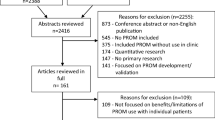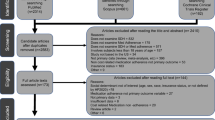Abstract
African American women bear a disproportionate burden of HIV disease. Socioeconomic and psycho-social factors while adding to the vulnerability of this population also contribute to non-adherence and consequently poor outcomes. The provider-patient relationship has the potential to enhance HIV medication adherence in this population. Using in-depth interviews, patient and provider perspectives are explored to identify specific elements of the provider-patient interaction that enhance patient satisfaction with care and consequently improve HIV medication adherence. Themes associated with provider attitudes and actions perceived as positively impacting care in this patient group include (1) physical touch, (2) treating (the patient) “as a person”, (3) actively listening to the patient, (4) showing empathy, (5) being non-judgmental, and (6) being readily accessible. These findings suggest that the demonstration of care and commitment from the provider as perceived by the patient is important to African American women living with HIV and may significantly influence adherence behavior and enhance treatment outcomes in this population.
Similar content being viewed by others
References
Centers for Disease Control and Prevention. Monitoring selected national HIV prevention and care objectives by using HIV surveillance data—United States and 6 U.S. dependent areas—2010. HIV Surveillance Supplemental Report 17 (3). http://www.cdc.gov/hiv/library/reports/surveillance/2010/surveillance_Report_vol_17_no_3.htmlPublished June 2012. Accessed October 21, 2015
Centers for Disease Control and Prevention. HIV Surveillance Report. Vol. 23. http://www.cdc.gov/hiv/library/reports/surveillance/2011/surveillance_Report_vol_23.html. Published February. 2011;2013 .Accessed October 22, 2015
Quinn SC. AIDS and the African American woman: the triple burden of race, class, and gender. Health Education & Behavior. 1993;20(3):305–20.
Johnson MO, Chesney MA, Goldstein RB, Remien RH, Catz S, Gore-Felton C, Charlebois E, Morin SF. Positive provider interactions, adherence self-efficacy, and adherence to antiretroviral medications among HIV-infected adults: a mediation model. AIDS Patient Care & STDs. 2006;20(4):258–68.
Schneider J, Kaplan SH, Greenfield S, Li W, Wilson IB. Physician-patient relationships and adherence better physician-patient relationships are associated with higher reported adherence to antiretroviral therapy in patients with HIV infection. J Gen Intern Med. 2004;19:1096–103.
Saha S, Jacobs EA, Moore RD, Beach MC. Trust in physicians and racial disparities in HIV care. AIDS Patient Care STDs. 2010;24(7):415–20.
Halbert CH, Armstrong K, Gandy Jr OH, Shaker L. Racial differences in trust in health care providers. Arch Intern Med. 2006;166(8):896–901.
Jacobs EA, Rolle I, Ferrans CE, Whitaker EE, Warnecke RB. (2006). Understanding African Americans’ views of the trustworthiness of physicians. J Gen Intern Med. (6):642–7.
Thrasher AD, Earp JA, Golin CE, Zimmer CR. Discrimination, distrust, and racial/ethnic disparities in antiretroviral therapy adherence among a national sample of HIV-infected patients. J Acquir Immune Defic Syndr. 2008;49:83–93.
Beach CM, Saha S, Korthius PT, Sharp V, Cohn J, Wilson IB, Eggly S, Cooper LA, Roter D, Sankar A, Moore R. Patient–provider communication differs for black compared to white HIV-infected patients. AIDS Behav. 2011;15:805–11.
Glaser B, Strauss A. The discovery of grounded theory. New York: Aldine Publishing Company, Chicago; 1967.
Okoro ON, Odedina FT. Improving medication adherence in African American women living with HIV/AIDS: leveraging the provider role and peer involvement. AIDS Care. 2016;28(2):179–85.
Verghese A. A touch of sense. Health Aff, 2009; 28(4): 1177–1182. Available at http://content.healthaffairs.org/content/28/4/1177.full.html
Montague E, Chen P, Xu J, Chewning B, Barrett B. Nonverbal interpersonal interactions in clinical encounters and patient perceptions of empathy. J Participat Med. 2013 Aug 14;5:e33.
Butts JB, Janes S. Transcending the latex barrier: the therapeutics of comfort touch in patients with acquired immunodeficiency syndrome. Holistic Nursing Practice Journal. 1995;10(1):61–7.
Connor A, Howett M. A conceptual model of intentional comfort touch. J Holist Nurs. 2009;27(2):127–35.
Carr AJ, Donovan JL. Why doctors and patients disagree. Br J Rheumatol. 1998;37(1):1–4.
Eisenberg L. Disease and illness: distinctions between professional and popular ideas of sickness. Cult Med Psychiatry. 1997;1(1):9–23.
St Claire L, Watkins CJ, Billinghurst B. Differences in meanings of health: an exploratory study of general practitioners and their patients. Family Pract. 1996;13(6):511–6.
Green AR, Caarrillo JE, Betancourt JR. Why the disease-based model of medicine fails our patients. West J Med. 2002;176(2):141–3.
Helman CG. Disease versus illness in general practice. J R Coll Gen Pract. 1981;31(230):548–52.
Lang F, Floyd MR, Beine KL. Clues to patients' explanations and concerns about their illnesses. A call for active listening. Arch Fam Med. 2000;9(3):222–7.
Street RL, Buller DB. Nonverbal response patterns in physician-patient interactions: a functional analysis. J Nonverbal Behav. 1987;11(4):234–53.
Robertson K. Active listening: more than just paying attention. Aust Fam Physician. 2005;34(12):1053–5.
Henry SG, Fuhrel-Forbis A, Rogers MA, Eggly S. Association between nonverbal communication during clinical interactions and outcomes: a systematic review and meta-analysis. Pat Educ & Counsel. 2012;86(3):297–315.
Brion J. The patient-provider relationship as experienced by a diverse sample of highly adherent HIV-infected people. J Assoc Nurses AIDS Care. 2014;25(2):123–34.
Sesko AK, Biernat M. Prototypes of race and gender: the invisibility of black women. J Exp Soc Psychol. 2010;46(2):356–60.
Apollo A, Golub SA, Wainberg ML, Indyk D. Patient-provider relationships, HIV and adherence: requisites for a partnership. Soc Work Health Care. 2006;42(3–4):209–24.
Flickinger TE, Saha S, Roter D, Korthuis PT. Sharp V. Cohn J, Eggly S, Moore RD, Beach MC. Clinician empathy is associated with differences in patient-clinician communication behaviors and higher medication self-efficacy in HIV care. Patient Educ Couns 2016; 99(2):220–226.
Schuster MA, Collins R, Cunningham WE, Morton SC, et al. Perceived discrimination in clinical care in a nationally representative sample of HIV-infected adults receiving health care. J Gen Intern Med. 2005;20(9):807–13.
Nyblade L, Stangl A, Weiss E, Ashburn K. Combating HIV stigma in health care settings: what works? J Int AIDS Soc. 2009;12(1):15.
Kinsler JJ, Wong MD, Sayles JN, Davis C, Cunningham WE. The effect of perceived stigma from a health care provider on access to care among a low-income HIV-positive population. AIDS Patient Care STDs. 2007;21(8):584–92.
Sullivan LM, Stein MD, Savetsky JB, Samet JH. The doctor-patient relationship and HIV-infected patients’ satisfaction with primary care physicians. J Gen Intern Med. 2000;15(7):462–9.
Dang BN, Westbrook RA, Black WC, Rodriguez-Barradas MC, Giordano TP. Examining the link between patient satisfaction and adherence to HIV care: a structural equation model. PLoS One. 2013;8(1):e54729.
Author information
Authors and Affiliations
Corresponding author
Ethics declarations
All procedures performed in this study involving human participants were in accordance with the ethical standards of and approved a priori by the Institutional Review of the University of Florida.
Funding
This study was funded by the Schlumberger Foundation through the Faculty for the Future Fellowship and the Sherri Aversa Dissertation Completion Award.
Informed Consent
Informed consent was obtained from all individual participants included in the study.
Rights and permissions
About this article
Cite this article
Okoro, O., Odedina, F. HIV Treatment in African American Women—Care That Makes a Difference. J. Racial and Ethnic Health Disparities 4, 376–384 (2017). https://doi.org/10.1007/s40615-016-0238-8
Received:
Revised:
Accepted:
Published:
Issue Date:
DOI: https://doi.org/10.1007/s40615-016-0238-8




